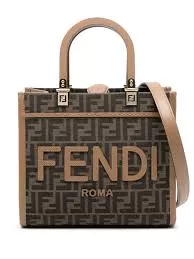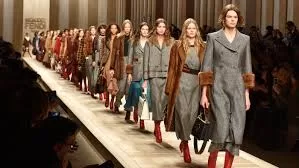Fendi is an icon of the most precious and famous names of luxury fashion. Characterized by master craftsmanship, dramatic design, and ageless beauty, it is now a leader in both ready-to-wear and accessories markets since its origin in 1925. A rich Italian brand, with strong historical values deeply committed to the concept of quality, innovation, and artistry, is indeed a potent force in luxury. From its iconic fur products to the famous Baguette bag, Fendi solidified its ground as a great fashion brand. This paper aims to dig deep into the company’s history of rich legacy, evolve through design developments, and stand out through continued influence in current fashion trends.

A History of Craftsmanship and Innovation
Founded in 1925 in Rome, Italy by Edoardo and Adele Fendi, this humble small fur and leather shop took no time and was recognized across Italian fashion houses because of dedication and keen observance toward good quality and fine finishes. Reputation over rich furs and premium-quality leather items got around to letting people identify a mark named Fendi among others with regard to an exquisite range within the very competitive environment of the clothing and accessory businesses.
After Karl Lagerfeld was hired as the creative director in the 1960s, it entered a new wave of innovation. The introduction of the double “F” logo of the brand under Karl Lagerfeld’s leadership helped shape Fendi’s styles. This is one of the most recognizable symbols in fashion and was one bold step taken in branding: it solidified it’s standing in the luxury market.
It was Lagerfeld who balanced the heritage of Fendi with modern sensibilities and, through a series of groundbreaking collections, gave the brand a new face. He brought in innovations in fur use, experimenting with new materials. In addition to fur, Lagerfeld extended the brand’s product lines beyond fur to include ready-to-wear collections and accessories that were soon part of the wardrobes of the fashion elite.

The Iconic Baguette Bag: A Symbol of Luxury
No discussion of Fendi’s influence on fashion is complete without mentioning the Baguette bag. Introduced in 1997, the Baguette became an instant sensation. The bag’s compact, rectangular shape, paired with a sleek design and signature FF logo, made it a must-have accessory for fashion lovers around the world.
The Baguette bag achieved iconic status after Sarah Jessica Parker’s character, Carrie Bradshaw, famously used it in the popular TV series Sex and the City. This helped catapult Fendi into the global stage and made the Baguette synonymous with chic sophistication. Through the years, it has continued to produce new releases of the Baguette and keep it up-to-date by changing its design with newer materials, colors, and styles.
What sets the Baguette apart from other luxury handbags is its craftsmanship. Fendi’s artisans meticulously handcraft each bag using only the finest leather and materials. The attention to detail and quality that goes into every piece is a testament to Fendi’s commitment to excellence. The Baguette remains a beloved symbol of it’s ability to create timeless, luxurious accessories that transcend trends.
Fendi’s Relationship with Fur: Tradition Meets Innovation
Fendi’s use of fur has been the official hallmark of the brand for decades. They have been known for making the most luxurious and creative pieces of fur in the world. They were pioneers of fashion when it came to breaking free from traditional design made from fur. While stuffy and conservative was often the perception of those heavier, older garments, made fur a modern luxury.
Under Lagerfeld, Fendi revolutionized the use of fur and made it a fashionable statement. The brand became renowned for creating furs in colours, textures, and patterns not seen before in the fashion industry. From coats to accessories, it’s creative use of fur helped redefine its place in high fashion, establishing it as something luxurious and avant-garde.
Although Fendi’s relationship with fur has sometimes been controversial, the brand has adjusted to changing attitudes toward fur in the fashion industry. It has continued to showcase its commitment to high-quality craftsmanship and sustainability by exploring alternative materials while still preserving its rich history and expertise in fur.

Fendi’s Expansion: Accessories and Beyond
Although furs are a core part of Fendi’s identity, the brand has widened its scope in recent years to include a diverse range of luxury products. It has always been famous for accessories, from the classic Peekaboo bag to elegant shoes and eyewear. The brand has always been on the forefront of innovation, making unique and highly coveted items that carry the hallmark of Fendi.
Fendi’s ready-to-wear collections have also made a significant impact on the fashion world. From sleek tailoring to bold streetwear-inspired designs, Fendi’s fashion shows have become a highlight of the global fashion calendar. The brand has successfully blended contemporary styles with its heritage of Italian craftsmanship, offering a unique perspective on luxury fashion that appeals to both traditional and modern sensibilities.
Another contributing factor to its continuous success has been the designer’s collaboration with other designers and artists. These are few collaborations through limited-edition collections with Kim Jones, Silvia Venturini Fendi, and Nicki Minaj that keep it on top of the cultural discussions of today’s younger consumers.
Fendi in the Digital Age: Connecting New Markets
From technology to new styles, Fendi has adopted its various revolutions in the light of changing situations. Digital media and social applications have helped Fendi reach fashion consumers across the world, giving followers a view into its collections, as well as to the processes they maintain behind the cameras.
Fendi has made headways in sustainability, not turning a deaf ear to the industry’s demand for sustainability. Starting with green material use and clear manufacturing, Fendi made the argument of luxury going along with sustainability possible. And so, only that much, has sustainability contributed towards increasing its own importance for relevance, now where customers increasingly ask for less destructive consumption practices in an increasingly earth-conscious generation.

Fendi Today: The Global Leader in Luxury Fashion
Fendi today remains on the top of the luxury fashion world. The house continues its path in innovative design while still holding its rich heritage aloft. The fact that this house, founded by the Fendi family, Karl Lagerfeld, and successive creative geniuses, can stay relevant while holding itself to its roots is an inspiration in itself.
It’s collections remain a favorite among fashion lovers and celebrities alike, as the brand continues to push the boundaries of what is possible in luxury fashion. Whether it is the timeless appeal of the Baguette, the innovative designs seen on the runway, or the brand’s commitment to craftsmanship, it’s legacy continues to shine brightly in the fashion world.
Conclusion
As Fendi moves forward, the future looks incredibly bright. Its untarnished stance on innovation, excellence, and timeless luxury will serve as a symbol of elegance and class for generations to come.
Fendi has shown the world that it is really more than a clothing brand, but it is an emblem of Italian tradition, its innovation, and timeless style. Through its rich history, iconic designs, and influence in the fashion world, it has established itself as a true leader in luxury fashions. As it continues to evolve and innovate, the brand remains powerful, shaping the future of fashion.

One thought on “Fendi: The Unstoppable Legacy of Luxury, Innovation, and Timeless Elegance”